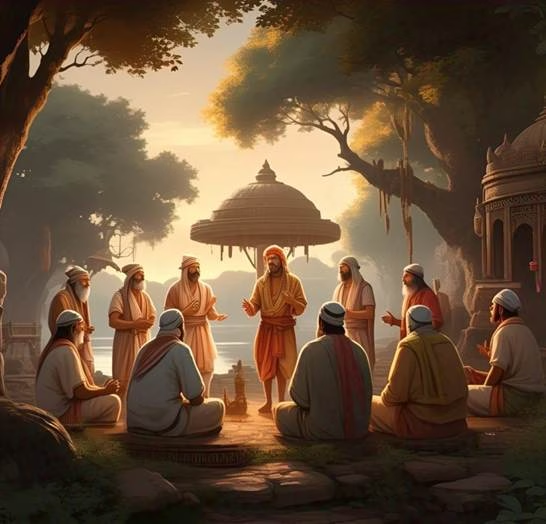
Espionage in ancient India was not a peripheral concern—it was an intrinsic part of governance, war strategy, and moral-political philosophy. From the mythical tales of Hanuman in the Ramayana to the intricate doctrines of Kautilya in the Arthashastra, the Indian subcontinent cultivated a rich tradition of state intelligence that was both pragmatic and deeply embedded in dharmic thought. This article traces the evolution of Indian espionage from divine narratives to realpolitik, revealing its complex role in shaping statecraft across centuries.
Hanuman: The Divine Spy and Strategist
In the Ramayana, Hanuman is much more than a devoted servant of Lord Rama. He is also a master of covert operations. His leap to Lanka to locate Sita marks one of the most emblematic reconnaissance missions in ancient literature. Hanuman’s task was not simply physical; it involved stealth, disguise, psychological insight, and battlefield analysis.
Upon reaching Lanka, Hanuman assessed the city’s fortifications, gauged the strength and morale of Ravana’s forces, and located Sita’s whereabouts. His observations laid the foundation for Rama’s later military strategy. Moreover, he used tactics that mirrored modern intelligence methods—interception, infiltration, and sabotage (e.g., burning a section of Lanka after being caught, creating panic and diversion).
This depiction shows how mythology framed espionage as not only essential to war, but as a righteous and even divine activity when conducted in the pursuit of justice.
Mahabharata: Espionage in the Age of Dharma and Deceit
The Mahabharata offers a more grounded political canvas. Here, espionage is shown not as divine intervention but as a critical tool in political maneuvering. Lord Krishna, the greatest diplomat of the epic, frequently employs information networks to understand both the Pandavas’ and Kauravas’ positions. Vidura, the wise minister of Dhritarashtra, uses secret channels to warn the Pandavas of plots against them, including the infamous “Lakshagraha” incident where they were to be burned alive.
During the Rajasuya Yagna and the preparations for the Kurukshetra war, espionage played a pivotal role. Spies moved between kingdoms, gathering data about alliances, military strengths, and weaknesses. In several passages, kings are advised to use informants posing as wandering monks, merchants, and even concubines—reflecting a nuanced understanding of psychological and social leverage.
Kautilya’s Arthashastra: Espionage as State Doctrine
While mythology and epic poetry glorified espionage in action, Kautilya (also known as Chanakya or Vishnugupta), gave it structure. In the Arthashastra, composed around the 4th century BCE during the rise of the Mauryan Empire, espionage is elevated to a science. Kautilya outlines an entire network of spies known as the Gudhapurusha, classified into different roles: Samsthān, Sanchār, Udasthita, and Tīkshna, each trained for specific tasks ranging from surveillance to subversion.
One of his most insightful contributions is the use of “double agents” and the need for counter-intelligence. Kautilya also recognizes the internal utility of espionage—spies were tasked not only with tracking external threats but also monitoring corrupt officials, rebellious elements within the army, and dissent among the populace.
Importantly, Kautilya doesn’t romanticize spies. He recognizes the moral ambiguity of their work and permits the use of deception, seduction, and even assassination if it serves Rājanīti (state interest). His pragmatic realism echoes Machiavelli, though Kautilya predates him by nearly 1800 years.
Other Classical Sources: The Dharmashastra and Smritis
Beyond the epics and political treatises, various Smritis and Dharmashastras—including the Manusmriti and Yajnavalkya Smriti—refer to the use of spies in legal and administrative matters. Kings are advised to test the loyalty of ministers and generals through covert means. Trials sometimes included secret testimony gathered by informants. In these texts, espionage is not portrayed as dishonorable but as necessary for the maintenance of order (dharma).
Even the Puranas, particularly the Agni Purana and Matsya Purana, briefly mention espionage as a king’s duty, classifying it under raja-dharma (the king’s obligation to protect the realm).
Case Study: Chandragupta Maurya’s Rise
Historical records and traditional accounts describe how Chandragupta Maurya, mentored by Kautilya, used a vast spy network to overthrow the Nanda dynasty and later challenge Alexander’s successors in the northwest. The detailed observation of Nanda weaknesses and the coordination of popular unrest were made possible through intelligence cells working across Magadha and beyond.
Later, under Emperor Ashoka, intelligence played a less militaristic but equally significant role. Ashoka’s governance model relied heavily on information gathered through mahamatras (officials) who were also tasked with moral surveillance, ensuring adherence to Dhamma across the empire.
Espionage and Ethics: A Delicate Balance
What sets the Indian tradition of espionage apart is its integration with ethical and philosophical thought. Unlike purely utilitarian views of intelligence, Indian texts constantly wrestle with the dharma of spying. Hanuman’s spying is justified by the moral duty to rescue Sita. Kautilya, though ruthlessly practical, repeatedly emphasizes that the end goal must be a stable and righteous rule.
Therein lies the tension: espionage, while grounded in deception, must ultimately serve justice. This balance between strategic necessity and moral accountability is what gave Indian statecraft its enduring philosophical character.
Legacy and Relevance Today
While modern intelligence institutions are shaped by colonial legacies and global models, India’s ancient texts provide a native precedent for a sophisticated, layered, and morally contoured vision of espionage. Figures like Hanuman, Vidura, and Kautilya continue to inspire military and political thinking—not just as mythical or historical icons, but as symbols of indigenous strategic acumen.
This legacy reminds us that intelligence gathering is not merely about secrets—it’s about foresight, restraint, and state responsibility.
Subscribe to Our Newsletter
Get the latest CounterCurrents updates delivered straight to your inbox.
Ashish Singh has finished his Ph.D. coursework in political science from the NRU-HSE, Moscow, Russia. He has previously studied at Oslo Metropolitan University, Norway; and TISS, Mumbai.














































